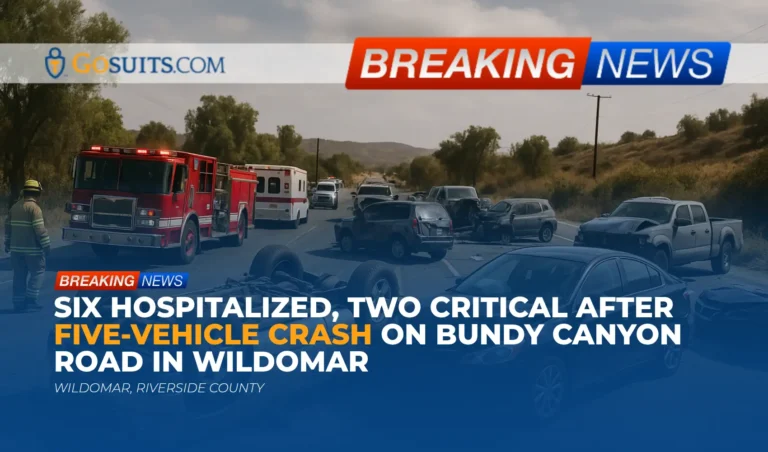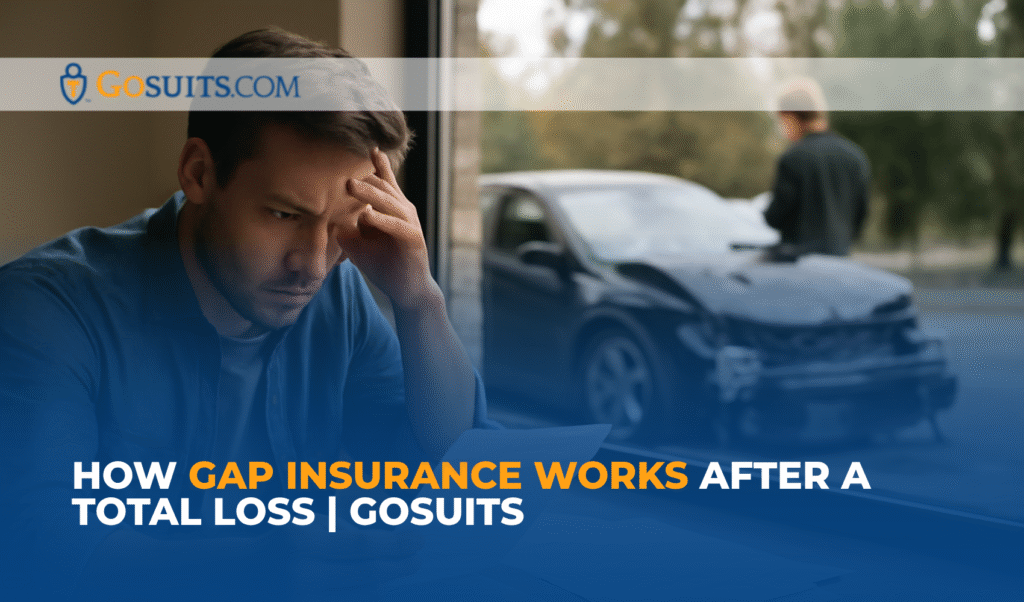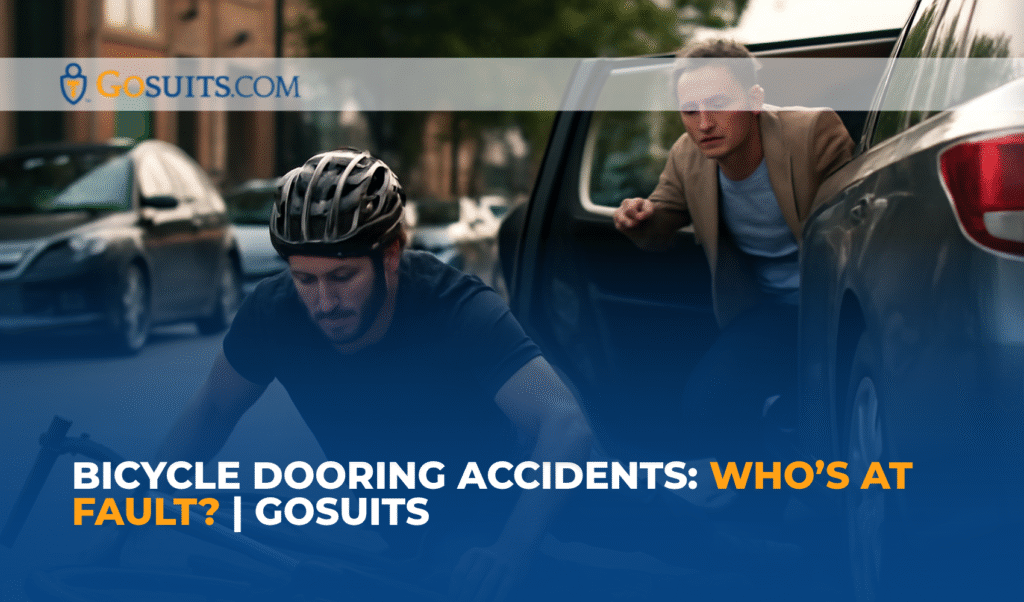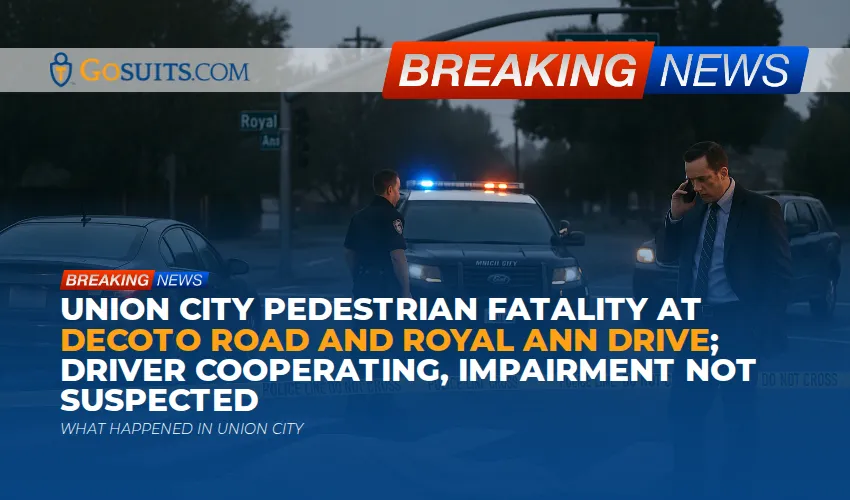- What Happened in the Wildomar Multi-Vehicle Crash
- Where the Investigation Stands and Why Cause Determinations Take Time
- Why Multi-Vehicle Crashes Are Complex in California Civil Claims
- Potential Sources of Civil Liability That May Be Explored
- Injuries Often Seen in Rollovers and Multi-Vehicle Collisions
- Practical Steps People Commonly Take After a Serious Crash in Riverside County
- How to Obtain Official Records and Documents in Riverside County
- Insurance and Claims in California: What Typically Applies
- Timeframes and Legal Deadlines That Often Apply in California
- Community Safety Notes for Rural and Semi-Rural Roads
- What Loved Ones Can Track and Preserve
- Commentary from Gosuits Wildomar, California Personal Injury Attorney
- Time-Sensitive Action Steps and Why Timing Matters
What Happened in the Wildomar Multi-Vehicle Crash
Six people were hospitalized following a five-vehicle collision on Saturday, October 25, 2025, in Wildomar, Riverside County. Fire crews responded shortly before 2 p.m. to the area of Bundy Canyon Road and Oak Circle Drive. Two individuals reportedly suffered critical injuries and four had minor injuries. A photo released by fire officials shows at least one Ford pickup truck overturned and resting on its roof after the impact. Nearby roads were temporarily closed while first responders secured the scene and investigators documented evidence. Fire authorities turned the matter over to local law enforcement for further investigation. As of the most recent public updates, the precise cause of the crash has not been announced.
When an incident involves several vehicles and serious injuries, it is common for agencies to conduct a thorough, step-by-step collision reconstruction. That can take days or weeks depending on the availability of witnesses, vehicle data, roadway conditions, and any specialized analyses required.
Where the Investigation Stands and Why Cause Determinations Take Time
Officials have indicated that the incident remains under investigation. In multi-vehicle crashes, investigators generally look at driver actions, vehicle conditions, road features, visibility, and any environmental or traffic influences. Modern vehicles may store crash-related data, and investigators often gather physical evidence such as skid marks, debris fields, and impact points to determine speed and sequence of impacts. They also review medical transport records and interview witnesses to construct a timeline.
The process often includes:
- Scene documentation including measurements, diagrams, photographs, and roadway evidence.
- Vehicle inspections for damage patterns and potential mechanical issues. Many vehicles have Event Data Recorders that can capture pre-impact speed, braking, and seat belt status, as described by NHTSA.
- Review of driver factors such as speed, distraction, impairment, following distance, and compliance with traffic control.
- Environmental and infrastructure assessment including lighting, signage, road surface, and visibility constraints.
Because the cause has not been publicly determined, it is important to avoid assumptions. Findings typically appear in official collision reports or statements from the investigating agency once available.
Why Multi-Vehicle Crashes Are Complex in California Civil Claims
Five-vehicle collisions are complex because there can be several impact events, multiple contributing factors, and overlapping insurance questions. California uses a comparative fault system, which means each party’s share of responsibility can be apportioned by percentage. Jurors receive instructions to weigh the conduct of all involved parties, reflected in the California Civil Jury Instructions for comparative fault, such as CACI No. 405 hosted by the California Courts.
In practical terms, responsibility can be shared among multiple drivers, and sometimes non-driver entities if road design, traffic control devices, or vehicle defects played a role. The sequence of impacts can affect how injuries occurred and which policies might be implicated. Event Data Recorder information, dash cameras, 911 audio, and third-party surveillance can all influence fault determinations.
Potential Sources of Civil Liability That May Be Explored
Driver-related factors
Investigators often examine whether any driver engaged in unsafe behaviors like speeding, following too closely, unsafe lane changes, or distraction. NHTSA reports that speeding increases crash severity and reduces a driver’s ability to steer safely around curves or objects and extends the distance necessary to stop. See NHTSA Speeding for national research and safety context. NHTSA also provides information about distraction risks that can lead to rear-end or chain-reaction collisions across multiple vehicles. See NHTSA Distracted Driving.
Vehicle dynamics and rollover
Photographs from the scene show at least one pickup overturned. Tall, narrow vehicles can be more prone to rollover compared to lower passenger cars due to center-of-gravity dynamics, especially in abrupt maneuvers or multi-impact sequences. NHTSA’s overview of rollover risk and prevention provides helpful background at NHTSA Rollover. The presence of a rollover does not by itself identify fault; it is one piece of the overall analysis.
Roadway conditions and traffic control
Rural and semi-rural intersections can present sight-distance issues, changing speed environments, or limited shoulders. Investigations sometimes consider signage, pavement markings, lighting, and road surface. If roadway conditions or design are implicated, claims may involve a public entity. This requires specialized notice procedures under California law, discussed further in the deadlines section below.
Vehicle defects and maintenance
If a component failure contributed, such as brakes or tires, that could raise issues for manufacturers or maintenance providers. Determining this typically requires prompt inspection and preservation of parts.
Injuries Often Seen in Rollovers and Multi-Vehicle Collisions
Our thoughts are with those hospitalized and their families. Rollover and multi-vehicle crashes can lead to a wide range of injuries, from soft tissue trauma to fractures, head injuries, and internal injuries. The Centers for Disease Control and Prevention notes that traumatic brain injuries can result from sudden bumps or blows to the head and may present with subtle or delayed symptoms. For general information, see the CDC’s pages on head injury and TBI at CDC TBI.
Even when initial injuries are described as minor, symptoms can evolve. It is common for individuals to undergo follow-up care to address pain, stiffness, or neurologic changes that were not obvious at the scene. Keeping medical appointments and documenting symptoms helps clinicians make timely decisions about treatment.
Practical Steps People Commonly Take After a Serious Crash in Riverside County
This section shares general steps that are often helpful after a multi-vehicle collision. Every situation is unique, and safety and medical care come first.
- Prioritize medical evaluation. Seek prompt care and follow medical advice. Some injuries are not immediately apparent.
- Preserve evidence. Save photos, videos, and contact details for witnesses. Keep damaged property and do not dispose of vehicle parts until inspections are complete.
- Keep a symptom and expense log. Track pain levels, missed work, prescriptions, and out-of-pocket costs.
- Be cautious with insurance communications. Before contacting any insurance adjuster, consider consulting an attorney. Statements given to insurers can be used to dispute fault or injuries later.
- Request official reports when available. Collision reports, fire run sheets, and medical records provide critical details needed for claims and care coordination.
- Mind the required driver reports. In California, drivers must report collisions to the DMV in certain circumstances, and injury collisions have additional reporting duties described below.
How to Obtain Official Records and Documents in Riverside County
Collision report
Collision reports are issued by the agency that investigated the crash. In the Wildomar area, traffic incidents may be investigated by the Riverside County Sheriff’s Office or the California Highway Patrol depending on jurisdiction and roadway.
- California Highway Patrol. If CHP investigated, you can search for instructions on obtaining a report through the CHP portal. See CHP collision reports. Eligible requesters typically include involved drivers, their representatives, and insurers.
- Riverside County Sheriff’s Office. If the Sheriff handled the report, visit the Sheriff’s website for records request information and station contact details. See Riverside County Sheriff. The Wildomar area is commonly served by the Lake Elsinore Station.
Driver reporting duties
- DMV SR-1. California requires that a traffic collision be reported to the DMV within 10 days if anyone is injured or there is property damage over a stated threshold. The DMV’s SR-1 page explains who must file and how. See DMV SR-1 reporting.
- Injury collisions and police notification. California Vehicle Code section 20008 requires drivers involved in collisions resulting in injury or death to make a written report to the police or CHP within 24 hours if a law enforcement officer did not investigate at the scene. See the statute text at CVC 20008.

Fire department records
Riverside County Fire Department, in cooperation with CAL FIRE, often generates incident logs and medical run sheets for emergency responses. Information about the department is available at Riverside County Fire. Certain records may be requested by involved parties subject to privacy laws.
Coroner’s office and autopsy records
In crashes involving a fatality, the Riverside County Sheriff-Coroner handles decedent investigations. Families typically can obtain certain records after official releases, subject to applicable rules. Visit the Sheriff’s site and navigate to the Coroner section from the homepage at Riverside County Sheriff.
Medical records
Hospitals and EMT providers maintain patient care records. Federal health privacy rules give patients access to their medical records in most circumstances. General information about individual rights under HIPAA is available from the U.S. Department of Health and Human Services at HHS HIPAA for Individuals.
Insurance and Claims in California: What Typically Applies
Multi-vehicle collisions involve several layers of potential coverage. The policies that may be implicated include:
- Liability coverage of any at-fault driver.
- Uninsured or underinsured motorist coverage on an injured person’s own policy if an at-fault driver lacks adequate coverage.
- Medical payments coverage that can assist with initial medical bills regardless of fault, if present on a policy.
- Property damage coverage for vehicle repair or total loss evaluations.
California regulates insurer claim handling. The Department of Insurance provides consumer resources and a complaint process if claim handling appears unfair. See the California Department of Insurance consumer complaint information at CA Department of Insurance.
It is common for insurance adjusters to request recorded statements and broad medical authorizations early in the process. Before speaking to any insurer or providing records, consider consulting a qualified attorney. Statements made to insurers can be used to minimize or dispute claims later, and signing broad authorizations may disclose unrelated private medical history.
Timeframes and Legal Deadlines That Often Apply in California
- Immediate safety and medical care. Seek timely medical treatment, both for health and to document injuries.
- DMV SR-1 deadline. Report to the DMV within 10 days when required. See DMV SR-1 reporting.
- Police reporting for injury collisions. If no officer investigated at the scene, drivers involved in injury collisions must submit a written report to the police or CHP within 24 hours. See CVC 20008.
- Statute of limitations for personal injury. California generally provides two years to file a civil action for personal injury. The California Courts Self-Help Center discusses how statutes of limitations work at California Courts: Statute of Limitations.
- Claims involving public entities. If alleging a dangerous condition of public property or other public-entity responsibility, special notice rules usually require a government claim within a much shorter period, often six months. The California Courts Self-Help page explains suing a public entity at Suing a Public Entity. Claims against state agencies are handled through the Government Claims Program described by the Department of General Services, while claims against cities or counties follow local claim procedures.
Deadlines can vary depending on facts, the parties involved, and the type of claim. Missing a deadline can affect legal options, which is why prompt attention to time limits is important.
Community Safety Notes for Rural and Semi-Rural Roads
Bundy Canyon Road and surrounding areas include stretches that feel rural or semi-rural, with changing speeds and access points that can invite sudden slowdowns or unexpected entries by other vehicles. National data show that higher speeds reduce drivers’ margin for error and increase crash severity. See NHTSA’s overview at NHTSA Speeding.
The Federal Highway Administration highlights that rural roads present unique safety challenges and over-represent a share of severe crashes relative to traffic volume. FHWA’s Rural Road Safety Program outlines these risks at FHWA Rural Road Safety. Drivers can help by allowing additional following distance, scanning for cross traffic near driveways and side roads, and slowing well in advance of congestion.
What Loved Ones Can Track and Preserve
In the weeks after a major collision, families often find it helpful to keep organized records. This can reduce stress and make later processes more manageable.
- Medical documentation. Hospital discharge papers, imaging reports, prescriptions, physical therapy notes, and a daily log of symptoms and limitations.
- Expense records. Receipts for co-pays, medication, medical devices, transportation to appointments, and repair or replacement of damaged property.
- Employment information. Time-off records, wage statements, and notes from employers regarding missed work or modified duties.
- Evidence of the crash. Scene photos, witness contacts, tow yard information, and estimates for vehicle damage. If possible, keep the vehicle available for inspection until advised otherwise, especially in rollover or multi-impact cases where structural analysis and Event Data Recorder retrieval may be important.
Commentary from Gosuits Wildomar, California Personal Injury Attorney
Our hearts go out to everyone affected by this multi-vehicle collision, especially those reported to be in critical condition and their loved ones. This article is intended for educational purposes and general information to help the community understand the civil and insurance aspects that often follow a serious roadway incident.
Based on what is publicly known, the crash involved five vehicles and at least one rollover, with two individuals critically injured. In our experience with complex roadway incidents, multi-vehicle sequences can be intricate to unwind. Responsibility is not always limited to a single driver, and careful attention to timing, vehicle movements, and roadway features matters. Preserving vehicles for inspection and obtaining official reports are crucial steps that often shape the outcome of claims.
Insurance companies and corporate defendants commonly move quickly after crashes. They may seek recorded statements, broad medical authorizations, or early settlements before the full scope of injuries and losses is known. This can take advantage of the fact that people are often overwhelmed after a traumatic event. Understanding rights, coverages, and deadlines before engaging with insurers can help prevent avoidable mistakes, such as unintentionally minimizing symptoms or consenting to disclosures beyond what is necessary.
Free consultations are an important resource in these situations. Speaking with a seasoned and skilled injury attorney early can help clarify options, identify coverage sources, and prioritize evidence preservation so that decisions are made with better information and less pressure.
Time-Sensitive Action Steps and Why Timing Matters
The period immediately following a serious crash can be confusing. Acting promptly can protect health, preserve rights, and avoid delays that may be hard to fix later.
- Get the right care, right away. Immediate and follow-up medical evaluation protects health and creates a clear record of injuries and treatment.
- Secure official documents. Obtain the investigating agency’s collision report when available, as well as fire department incident logs and complete medical records. These documents anchor timelines and substantiation.
- Preserve the vehicle and key evidence. Do not authorize disposal of a totaled vehicle until evaluations are complete. Keep photos, clothing, and damaged items. Evidence lost early can be difficult or impossible to re-create.
- Be intentional with insurance communications. Before giving statements or signing medical releases, seek legal guidance. Early misstatements can be used to dispute causation and damages.
- Calendar deadlines now. Note the DMV SR-1 reporting window, police reporting obligations for injury collisions, and civil limitation periods. Missing a deadline can restrict options later.
- Organize a single file. Consolidate bills, explanation-of-benefits forms, wage information, and correspondence. Good organization reduces stress and helps avoid missed reimbursements.
Additional Data and Safety Context
To place these events in broader context, national safety agencies publish data and guidance that help explain risk factors in severe crashes:
- Speed and severity. NHTSA reports that speeding remains a primary factor in fatal and serious-injury crashes. Higher speed increases stopping distances and crash energy. See NHTSA Speeding.
- Rollover risk. Taller vehicles can have a higher propensity for rollovers under sudden maneuvers or multi-impact scenarios. See NHTSA Rollover for prevention and vehicle design considerations.
- Rural road considerations. FHWA notes persistent safety challenges on rural roadways, including higher speeds and limited shoulders. See FHWA Rural Road Safety.
- Head injury awareness. The CDC provides guidance on recognizing and managing traumatic brain injuries, which may present with delayed symptoms. See CDC TBI.

Where Families Commonly Seek Help or Information
Below are public agencies and resources that often play a role after a serious collision in Riverside County:
- Collision reports: California Highway Patrol for CHP-handled investigations at CHP collision reports, or Riverside County Sheriff’s Office for Sheriff-handled investigations at Riverside County Sheriff.
- DMV accident reporting: California DMV SR-1 information at DMV SR-1 reporting.
- Fire incident records: Riverside County Fire Department information and contacts at Riverside County Fire.
- Coroner records: For fatal incidents, start at the Sheriff’s homepage and navigate to the Coroner section at Riverside County Sheriff.
- Insurance consumer help: California Department of Insurance consumer complaint page at CA Department of Insurance.
- Court self-help: California Courts information on statutes of limitations and public entity claims at Statute of Limitations and Suing a Public Entity.
A Careful Word About Insurance Communications
When a collision involves multiple vehicles, several insurers may call. Adjusters sometimes ask for recorded statements, employment information, and medical records in the first days after the incident. It is wise to consult an attorney before speaking with insurers or signing releases. What is said to an insurer can be cited later to dispute fault or injuries. Simple statements like feeling “okay” at the scene are often used to argue that later symptoms are unrelated, even when delayed symptoms are a known medical phenomenon.
People also commonly underestimate the scope of coverage potentially available, including underinsured motorist coverage on their own policy or medical payments provisions that can help with initial bills. Early, informed guidance can help identify and coordinate coverages while avoiding avoidable conflicts over statements or authorizations.
Closing Thoughts
This was a serious collision with multiple injured people and at least one rollover, and it affects an entire community. While officials continue their investigation, families and injured individuals can focus on medical recovery, organization, and timely information gathering. The resources above can help with obtaining official records and understanding the process ahead. If the crash involved a loved one, know that it is normal to feel overwhelmed by forms, insurance calls, and logistics. Step by step, with reliable information and support, the path forward becomes clearer.






